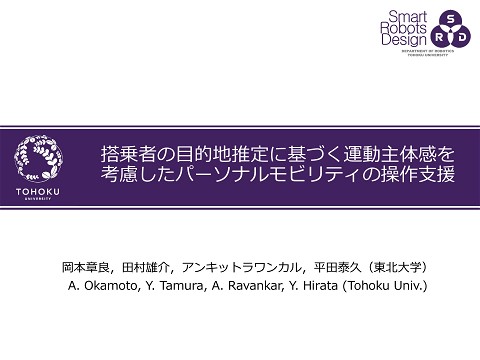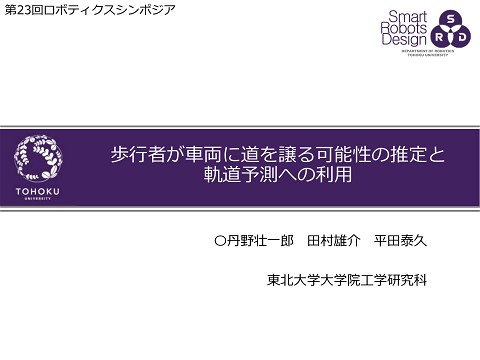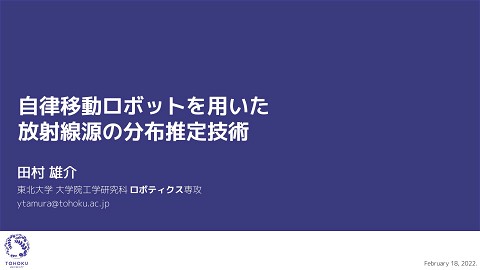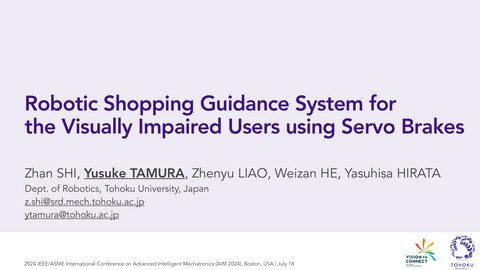Radiation Source Localization Considering Shielding Effect of Structures using 3D Object Recognition (SII2024)
827 Views
January 15, 24
スライド概要
Baduy Nguyen, Yusuke Tamura, Yasuhisa Hirata, "Radiation Source Localization Considering Shielding Effect of Structures using 3D Object Recognition," Proceedings of the 2024 IEEE/SICE International Symposium on System Integration, 2024.
東北大学大学院工学研究科ロボティクス専攻 田村研究室
関連スライド
各ページのテキスト
The 2024 IEEE/SICE International Symposium on System Integration (SII) Ha Long, Quang Ninh, Viet Nam, January 8-11, 2024 Robotic Teleoperation and Environmental Sensing TueAM2 Room M2, Duty Time: 10:45-11:00, Tuesday, January 9, 2024 Smart Robots Design DEPARTMENT OF ROBOTICS TOHOKU UNIVERSITY Radiation Source Localization Considering Shielding Effect of Structures Using 3D Object Recognition By Baduy Nguyen, Yusuke Tamura and Yasuhisa Hirata Graduate School of Engineering, Department of Robotics Tohoku University
Research background u Many contaminants (radiation sources) are present in the buildings of the nuclear power plant where the accident occurred ØHigh risk of radiation exposure to people working in the building ØTo ensure the safety of workers inside the reactor building, it is imperative to remove these sources. Fukushima Daiichi Nuclear Power Station[1] u Localization of these sources is necessary [1] [2] https://www.asahi.com/special/10005/TKY201111120447.html https://photo.tepco.co.jp/date/2014/201401-j/140117-01j.html 2024/1/11 Reactor Building [2] Smart Robots Design Lab. 1
Related Work The Maximum Likelihood-Expectation Maximization (ML-EM) method allows for highly accurate 3D position estimation of a radiation source The consideration of the shielding effect is not taken-into account Ø Estimation accuracy is adversely affected Considering the shielding effect of structures could lead to a more precise estimation Incidence Source Structure u Phenomenon in which radiation emitted from a source is reduced by shielding from structures: Radiation Source Localization Using ML-EM[3] Measured Value Attenuation Shielding Effect [3] D. Kim, H. Woo, Y. Ji ,Y. Tamura, A. Yamashita, H. Asama, “3D Radiation Imaging Using Mobile Robot Equipped with Radiation Detector,” Proceedings of the 2017 IEEE/SICE International Symposium on System Integration, pp.444–449, 2017 2024/1/11 Smart Robots Design Lab. 2
Research Purpose The development of a radiation source localization model takes into consideration the shielding effect of structures Achieving higher-precision radiation source location estimation 2024/1/11 Smart Robots Design Lab. 3
Concept Of Proposed Method Radiation Source Localization Considering Shielding Effect of Structures Recognition of Structures 2024/1/11 Dosimetry Correction with Shielding Effect Smart Robots Design Lab. Radiation Source Localization 4
Structures Recognition Method u Identify structures using 3D object recognition: Robot Ø Using Open3D [4] u Abundant libraries available in open source u Executable on various platforms Point-cloud of the environment measured with 3D LiDAR The Advantages of 3D Object Recognition Open3D ・ Identification of Objects not present in the Design Blueprint ・ Obtaining Information about Damaged Areas in the Environment [4] J. Behley, M. Garbade, A. Milioto, J. Quenzel, S. Behnke, C. Stachniss, J. Gall, “SemanticKITTI: A Dataset for Semantic Scene Understanding of LiDAR Sequences,” Proceedings of the IEEE/CVF International Conference on Computer Vision, pp.9297–9307, 2019. 2024/1/11 Point-cloud Smart Robots Design Lab. Recognized structures Output Pointcloud 5
Shielding Effect By Structures u The shielding of radiation depends on material and shape of structures →If the material and shape can be identified, it is possible to calculate the attenuation caused by the shielding object 3D Object Recognition Structures Information 2024/1/11 Design Blue-Print Detailed Material The Material and Shape of Structures Smart Robots Design Lab. Structure Ø Material: Linear attenuation coefficient Ø Shape: Thickness Attenuation Coefficient ! (Material) Incidence "# Measured Value " Thickness ! [m] (Shape) Dosimetry Correction is possible Calculate Attenuation Ratio Attenuation Ratio (Expressed by an exponential function) 6
Dosimetry Correction With Shielding Effect Incidence " Model Measured Attenuation due to #% u Using the Model proposed by Wright et al., (Want to know) Value " !=# ! u Information included in model: ØDistance between sensor and source information ØShielding effect information Incidence "#% )! *# + )!# , exp −0$ 1$ $ Distance # Sensor sensitivity $ Finite Value ( Obtained by iterative calculations, estimating the source position ) !!! = [5] T. Wright, A. West, M. Licata, N. Hawes, B. Lennox, “Simulating Ionising Radiation in Gazebo for Robotic Nuclear Inspection Challenges,” Robotics, vol.10, no.3, 86, 2021. 2024/1/11 $! !"! 1− 2 structures Smart Robots Design Lab. ! ∑" $" 1 − 2 )" *# + )"# ∏$ exp −0$ 1$ Model proposed by Wright et al.,[5] 7
Radiation Source Localization Method u Methods for radiation source localization: Ø The Maximum Likelihood-Expectation Maximization(ML-EM [6]): Capable of estimating source positions with higher accuracy than other methods u However, it requires high computational resources and time for measurement and estimation Ø Conducting ML-EM for the entire environment is Inefficient →Estimate areas with a high probability of existence of radiation sources and perform ML-EM centered around the areas→Efficient Ø Extended Kalman Filter [7] is adopted for area estimation • Incorporated into Simultaneous Localization and Mapping program (SLAM [8]), making realtime execution feasible [6] A. P. Dempster, N. M. Laird, D. B. Rubin, “Maximum Likelihood from Incomplete Data Via the EM Algorithm,” Journal of the Royal Statistical Society: Series B (Methodological), vol.39, no.1, pp.1‒38, 1977. [7] G. Welch, G. Bishop, “An Introduction to the Kalman Filter,” Univversity of North Carolina at Chapel Hill, TR95-041, 1995. [8] U. Frese, G. Hirzinger, “Simultaneous Localization and Mapping - A Discussion,” Proceedings of the IJCAI Workshop on Reasoning with Uncertainty in Robotics, pp.17‒26, 2001. 2024/1/11 Smart Robots Design Lab. 8
Maximum Likelihood-Expectation Maximization (ML-EM) u Algorithm of ML-EM: Ø Measurement data (Actual Projection Data, APD) from various angles, then reconstruct the image (Reconstructed Image) Ø Creating New Projection Data (NPD) from the reconstructed image Ø Sequentially updating the reconstructed image to approach APD by iteratively adjusting NPD Structure Reconstructed Image NPD→APD Source Obtaining the source position from the reconstructed image Adjusting APD 2024/1/11 APD NPD Smart Robots Design Lab. 9
Proposed ML-EM Model ML-EM Reconstructed Image Structure Object Recognition Output Image Source Attenuation ' Thickness ( APD APD Correction APD NPD NPD Correction Value "# Measured Value " Correction Model Dosimetry Correction Model 2024/1/11 Smart Robots Design Lab. Estimated Source Position (Distance %, Sensor Sensitivity &) 10
Simulation Validation Radiation source position estimation considering the shielding effect of structures Purpose: Compare and evaluate the results of the proposed method with the traditional ML-EM estimation u The software used for model evaluation: Ø the radiation measurement virtual program proposed by Wright et al., called 'Gazebo_Radiation_Plugin' [5] [5] T. Wright, A. West, M. Licata, N. Hawes, B. Lennox, “Simulating Ionising Radiation in Gazebo for Robotic Nuclear Inspection Challenges,” Robotics, vol.10, no.3, 86, 2021. 2024/1/11 Smart Robots Design Lab. 11
Simulation Condition u Collect Measured Data (Actual Projection Data) u Execute ML-EM offline Concrete Wall: ・Parallel Humidity: 60% ・Height: 3m ・Thickness: 0.4m Radiation Source: ・Gamma Source( "#$ $%) ・Intensity &% =4×10"" Bq Simulation Environment Jackal Robot Gamma Detector: ・ Directionality: None ・Range: 0~5000 cps 2024/1/11 30 deg Smart Robots Design Lab. 12
Distance between the estimated and truth source Simulation Result Truth Source Comparison of Reconstructed Image ■ Traditional ML-EM ■ Proposed ML-EM MSE Estimated Result by ML-EM 2024/1/11 Proposed ML-EM Traditional ML-EM Traditional ML-EM Proposed ML-EM 59.3 21.9 Results of MSE between the ground truth image and the reconstructed image Smart Robots Design Lab. 13
Estimating Process Traditional ML-EM 2024/1/11 Proposed ML-EM Smart Robots Design Lab. 14
Conclusion u A radiation source location estimation model considering the shielding effect of structures was proposed ØEstimation of the position of a single radiation source considering the shielding effect of structures using the proposed model u In the future, the plan is to perform estimation for multiple radiation sources 2024/1/11 Smart Robots Design Lab. 15
Future Work u Using data with noise for radiation source and detector for position estimation u Using an actual robots with gamma detectors and reevaluate the developed model in the real world 2024/1/11 Smart Robots Design Lab. 16





